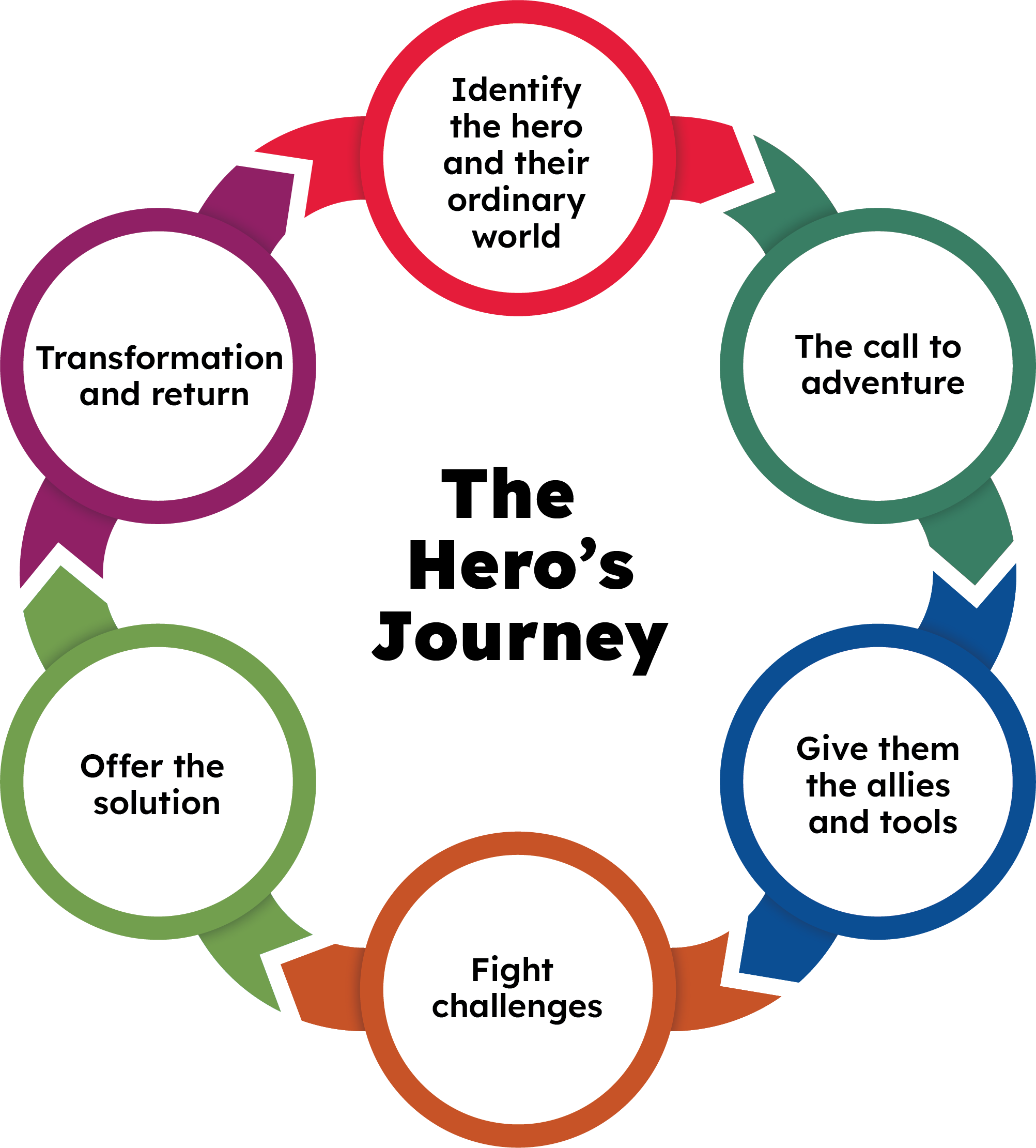Writing is hard. Especially when you are writing to engage a jaded audience or start a conversation about a complex topic. We’ve been there (too many times) and we’ve found one solution that always helps - tell a story.
A well-told story can connect with the audience’s emotions and influence people to act. It can help your audience believe in an idea.
Here are some storytelling techniques that we find most useful.
The hero’s journey
Grab your sunscreens and selfie sticks, we’re going to Los Angeles. The hero’s journey is a Hollywood-style storytelling framework that describes a transformational path taken by the story’s protagonist. It starts with an ordinary world where something is wrong, and the hero is called on to make things better. Stay with us, here is how it goes:
1. Identify the hero and their ordinary world:
The everyday hero represents the target audience, and the ordinary world could be an existing problem they are facing. Example: residents aged 18-24 who are enjoying the end of lockdowns and are resistant to getting the Covid-19 vaccine.
2. The call to adventure:

Identify your audience's challenges or needs and ascertain how to urge them to action. Example: engaging and fun social media campaigns that talk about the critical role of young people in stopping the spread of Covid-19.
3. Give them the allies and tools:
Provide your audience with the information they need to embark on their adventure. Example: Use TikTok videos of influencers and celebrities who are popular with this age group to address concerns about the vaccine and offer information and support.
4. Fight challenges:
Identify and address the barriers that can keep your audience from engaging with your campaign. Example: address misinformation and genuine fears that are stopping the target audience from getting vaccinated.
5. Offer the solution:
Introduce your campaign objective as the solution to the hero’s challenge and explain how it solves the hero’s problem. Example: Talk about the Covid-19 vaccine as a path to freedom and a safe return to normal life.
6. Transformation and return:
The hero improves their situation by following your campaign’s call to action. The transformed hero then becomes a voice for your campaign. Example: Young people sharing their “I’m vaccinated” selfies and talking about how simple the process was.
The council narrative
In this method, the organisation's narrative sets the framework for how a council communicates with residents and stakeholders. “Developing a council narrative – the ‘why’ of your organisation – has been seen for some time as a fundamental element of a communication strategy,” says the Local Government Association. You can read more about this in their guide to building your organisation’s narrative. The ‘why’ encompasses the council’s goals and intended impact on its community. The council narrative is similar to your brand story that talks about the council’s values, its mission, and what actions it can be held accountable for. This narrative serves as a guide for messaging and communication across various channels.
Freytag’s Pyramid
Like making a five-tier chocolate cake from scratch, this one is intense but worth it. Freytag’s Pyramid splits a story into five parts - exposition, rising action, climax, falling action, resolution - collectively designed to build tension and excitement. This framework is a good guide to planning the sequence of a communication campaign. The five stages also sync perfectly with a social media campaign cycle.
-
Exposition:
This is the beginning of your story where you introduce the situation, the characters and the conflict. Example: energy costs are rising and with a cold winter expected, this winter will be hard. This stage ends with an "inciting incident." Example: how will you afford to stay warm this winter?
-
Rising action:

The story unfolds here. More details about the problem, its solutions and consequences are revealed. This stage builds the tension around the conflict. Example: you can do something now to get the best energy tariffs that are being offered. Some of your neighbours have joined the energy switch collective and have switched to better tariffs.
-
Climax:
The climax is the turning point in the story. It is where the tension peaks and you reveal the core message of your campaign. Example: join our community collective energy switch and take advantage of the bargaining power of a large group.
-
Falling action:
In this step you provide information to support your core message and offer solutions to help your audience take decisions. Example: registration information, how the energy auction works, how many people have registered.
-
Resolution:
You’ve reached the final phase of your campaign narrative. This stage should highlight the benefits of your campaign and reinforce the positive outcomes of following your call to action. Example: Register now to join your neighbours and save on your energy bills. Include testimonials from residents who have joined the collective.
Go rogue
For you rebels - if the above techniques are too restrictive, tell your story your way.
Pick your story format based on your audience and marketing channel. Get into the mind of your audience and find an element of your marketing campaign that they will connect with the most. Will it be the villain – like rising living costs? Or the tragic victim who needs saving – like our planet from climate change? And everyone’s favourite, the cute character – little children preparing to start school? You can throw in some action scenes – libraries bustling with children taking part in a reading challenge. And end with a moral of the story – if you miss this deadline, your child will have a lower chance of getting their first preferred school.
Please remember that whichever storytelling framework you choose, the success of your communications campaign will fundamentally depend on the quality of your audience data.
Here’s to writing some award-winning stories. By ‘award’ we mean Pulitzer. And by ‘Pulitzer’ we mean audience engagement.
Leave a comment